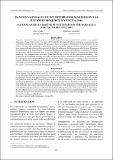Por favor, use este identificador para citar o enlazar este ítem:
https://hdl.handle.net/20.500.12958/3437Registro completo de metadatos
| Campo DC | Valor | Lengua/Idioma |
|---|---|---|
| dc.contributor.author | Tejada Cáceres, Alex | - |
| dc.contributor.author | González Vargas, Alejandro | - |
| dc.contributor.author | Baldarrago, Danny | - |
| dc.contributor.author | Liza, Carmen | - |
| dc.contributor.editor | Instituto del Mar del Perú | - |
| dc.date.accessioned | 2020-06-19T02:19:25Z | - |
| dc.date.available | 2020-06-19T02:19:25Z | - |
| dc.date.issued | 2020-06 | - |
| dc.identifier.citation | Inf Inst Mar Perú 47(2), 2020, p. 261-316 | es_ES |
| dc.identifier.issn | 0378-7702 | - |
| dc.identifier.uri | https://hdl.handle.net/20.500.12958/3437 | - |
| dc.description.abstract | Durante el 2016 se efectuaron prospecciones en los bancos naturales de las regiones Moquegua y Tacna, se analizó la información de la pesquería de los últimos 10 años; para identificar y delimitar dos áreas potenciales para maricultura en Tacna se realizaron levantamientos batimétricos y determinación del tipo de sedimento. En Moquegua se identificaron 26 bancos de fondo duro y 1 de fondo blando en los que se distribuyen 18 especies de importancia comercial. En Tacna se registraron 15 bancos de fondo duro y 3 de fondo blando, en los que se identificó 20 especies de importancia comercial. Las prospecciones mostraron bajas abundancias relativas de los principales recursos y alta proporción de ejemplares menores a las tallas mínimas de captura; el análisis de los datos de desembarque de la pesquería marisquera determinó que los recursos choro, caracol, pulpo, chanque y erizo presenta el mayor volumen de desembarque en los últimos diez años. En la región Tacna se están delimitando dos áreas potenciales para maricultura: Vila Vila (157,47 ha) y Cerro Moreno (246,58 ha). | es_ES |
| dc.description.abstract | ABSTRACT: In 2016, surveys were carried out in the natural banks of the Moquegua and Tacna Regions and the information on the fishery from the last 10 years was analyzed; bathymetric surveys and determination of the type of sediment were carried out to identify and delimit two potential areas for mariculture in Tacna. A total of 26 hard-bottomed and 1 soft-bottomed banks were identified in Moquegua, where 18 commercially important species are distributed. On the other hand, 15 hard-bottomed and 3 soft-bottomed banks were recorded in Tacna, where 20 commercially important species were identified. The surveys showed low relative abundances of the main resources and a high proportion of individuals below the minimum catch sizes; the analysis of the landing data of the seafood fishery determined that the ribbed mussel, snail, octopus, false abalone and sea urchin resources had the highest landing volume in the last ten years. Two potential mariculture areas are being defined in the Tacna Region: Vila Vila (157.47 ha) and Cerro Moreno (246.58 ha). | - |
| dc.language.iso | spa | es_ES |
| dc.publisher | Instituto del Mar del Perú | es_ES |
| dc.relation.ispartofseries | Informe IMARPE;47(2), 2020 | - |
| dc.rights | info:eu-repo/semantics/openAccess | es_ES |
| dc.rights.uri | https://creativecommons.org/licenses/by/4.0/ | es_ES |
| dc.source | Instituto del Mar del Perú - IMARPE | es_ES |
| dc.source.uri | Repositorio Digital IMARPE | es_ES |
| dc.subject | Bancos Naturales | es_ES |
| dc.subject | Tacna | es_ES |
| dc.subject | Invertebrados marinos | es_ES |
| dc.subject | Moquegua | es_ES |
| dc.subject | Maricultura | es_ES |
| dc.subject | Mariscos | es_ES |
| dc.title | Bancos naturales de invertebrados marinos en las regiones Moquegua y Tacna, 2016 | es_ES |
| dc.title.alternative | Natural banks of marine invertebrates in the Moquegua and Tacna Regions, 2016 | es_ES |
| dc.type | info:eu-repo/semantics/article | es_ES |
| Aparece en las colecciones: | Informe vol. 47(2) 2020 | |
Ficheros en este ítem:
| Fichero | Descripción | Tamaño | Formato | |
|---|---|---|---|---|
| Informe 47-2 articulo4.pdf | 5,74 MB | Adobe PDF |  Visualizar/Abrir |
Este ítem está sujeto a una licencia Creative Commons Licencia Creative Commons

